Journal of the NACAA
ISSN 2158-9429
Volume 10, Issue 2 - December, 2017
Timing Mechanical Weed Control in Pastures
- Landefeld, M. A., Extension Educator, Ohio State University Extension
Penrose, C.D., Extension Educator, Ohio State University Extension
McCutcheon, J.S., Southeast Region Director, Ohio State University Extension
Wiseman, T., Extension Educator, Ohio State University Extension
ABSTRACT
Weed control is an essential part of all forage production systems. Unwanted weeds compete for nutrients, water and sunlight needed for optimum forage growth. Mechanically mowing pastures is one method producers use if they do not want to spray herbicides. The purpose of this study, conducted at the Eastern Agriculture Research Station, Belle Valley, OH, is to determine if weed populations in pastured forages are affected by varying the timing of mowing to a height of four inches during the late spring and summer growing period without the use of herbicides. Treatments in this study consisted of a control (no mowing); June mowing; July mowing; August mowing; September mowing; June plus August mowing; July plus September mowing; and a monthly mowing June through September. Determining if mowing timing will affect weed pressure, forage composition and forage quality is important. Results from two years indicate a single mowing in June was not effective in controlling weeds. Mowing in July plus September controlled weeds over four of the five rating periods in the study. Mowing in June plus August, and mowing in August controlled weeds over three of the five rating periods.
Introduction
Ohio farms have more than 1.28 million cattle and calves, more than 117,000 sheep and lambs and more than 1.42 million acres in pasture land (Turner and Morris, 2015). Topography, soil profiles and the existence of many woodland acres limit large scale agronomic row crop production in parts of the state. Most of the non-wooded land in the Appalachian foothills of Ohio is used for production of cool season grasses for grazing livestock. Grazing livestock are used to harvest forages grown in pasture fields. Forages are an environmentally friendly crop that can protect soils from erosion, improve soil quality and enhance farm profitability. Weed growth in perennial grass pastures can reduce quality of the forage, quantity of useable forage and/or cause livestock mortality if poisonous weeds are consumed. Some weeds are not palatable so livestock reject eating them. Other weeds produce chemicals that are harmful to forage crop plants through a process called allelopathy. Allelopathy can reduce growth of forage plants that are desired in the pasture (Ferguson, et al., 2016).
Mechanical weed control most often refers to mowing with a sickle bar or rotary mower. In combination with other control methods such as good soil fertility practices and application of herbicides, mowing can be an effective tool in weed and brush management (Schnakenberg et al., 2010; Fynn et al., 2004). Broadleaf herbicides that control many problem weeds in Ohio pastures also reduce or eliminate legume plants that supply grass forages with nitrogen (N). Adequate available N is critical for maximum grass growth in pastures. Total forage yield increased when legumes were grown with tall fescue (Matches, 1979). Thus, if mowing weeds in pastures can reduce weed pressure, legume presence can be maintained. The purpose of this study is to determine if weed populations in pastured forages could be changed or reduced by varying the timing of mowing throughout the late spring and summer growing period without the use of herbicides.
Methods
To better understand the optimal timing(s) for mechanical weed control an experiment was established. The two-year study (2015-2016) was conducted at the Ohio Agriculture Research Development Center, Eastern Agriculture Research Station, Belle Valley, OH 39°46ʹ58.60ʺ N and 81°30ʹ33.30ʺ W on Vandalia-Guernsey silty clay loam soil. This was a randomized complete block design with eight treatments, including a control, and four replications of each treatment. Treatments consist of: (1) Control (no mowing); (2) June only mowing; (3) July only mowing; (4) August only mowing; (5) September only mowing; (6) June/August mowing; (7) July/September mowing; and (8) mown montly in June, July, August and September. Each plot measured 15 ft by 20 ft with an additional one-foot border along each side to allow mechanical mowing equipment to pass between marker posts. The experimental site is an existing rotationally grazed pasture field of predominately tall fescue and mixed grasses with various broadleaf weeds throughout the plots. Soil testing conducted before the experiment began and using Mehlich III extractant indicated the following: pH of 7.3; 243 ppm phosphorus, 401 ppm potassium, 456 ppm magnesium, 3037 ppm calcium and CEC of 19.8 meq/100g.
Weed ratings were collected near the beginning of each month from June through October. Each plot was rated for the amount of broadleaf weed pressure contained at the time by calculating the average of two or more independent visual assessments. A Likert-type scale of 0-9 was used with 0, meaning 0% of the plot area were weeds to 9, meaning 90% of the plot area were weeds. Ratings were conducted by independent evaluators each time and the mean rating was recorded. Each month, after rating the plots, 51 cow/calf pairs grazed the trial area until the desired amount of forage was removed. After each grazing, treatment plots were cut with a rotary mower (Bush Hog® 15ʹ Batwing) by making one pass over each plot and cutting to a four-inch plant height to follow the treatment plan (Fig. 1).
Data were analyzed using the MIXED procedure (SAS Inst. Inc., Cary, NC). The model for the data was rating (the response variable), fixed effects of treatment, period and treatment*period. Random effects were replication and year. Repeated measures were used for period within year, with the subject being the plot. Compound Symmetry was the covariance structure that yielded the smallest Bayesian information criterion. Simple effects were generated by the PDIFF with control function in SAS.
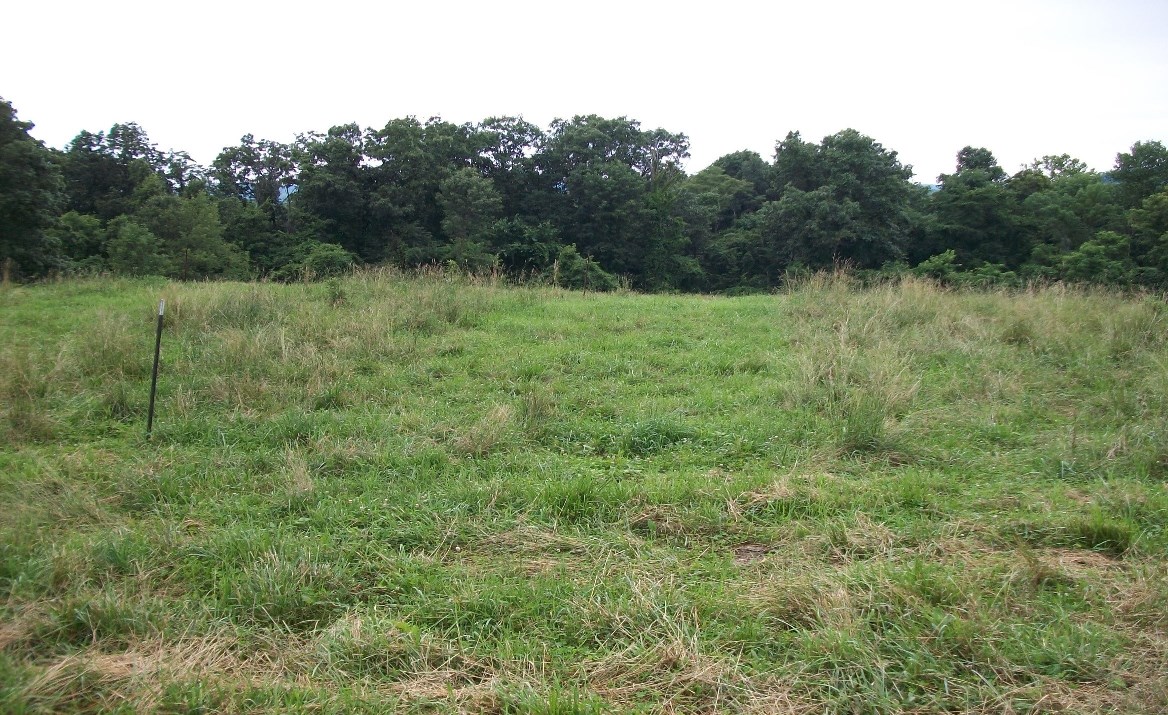
Figure 1. Plots shown in early July after June grazing and mown with a rotary mower according to layout and plan design.
Results
The results of the study showed variation among plots when the existing forage was observed late in the growing season. Physical size of some weeds stood out since they had not been mowed. Canada thistle (Cirsiuim arvense) and cocklebur (Xanthium sturmarium) were the most visible species in the plots. However, there were a variety of other weeds such as burdock (Arctium minus), dandelion (Taraxacum officinale), horsenettle (Solanum carolinense), ironweed (Vernonia gigantea), broadleaf plantain (Plantago major) and smartweed (Polygonum amphibium). Rainfall total during the treatment periods were similar, 19.76 inches in 2015 and 21.13 inches in 2016, but monthly amounts varied. In 2015 amounts ranged from 1.05 to 7.31 inches per month, but in 2016 it was 3.37 to 4.78 inches per month. Each growing season was different and rainfall amounts on the plots from the Eastern Agriculture Research Station weather station are listed in Table 1.
Table 1. Rainfall measured in inches during months plots were mowed.
| Year | May | June | July | August | September | 5 Month Total |
| 2015 | 2.39 | 7.31 | 3.20 | 1.05 | 5.81 | 19.76 |
| 2016 | 4.72 | 3.63 | 4.63 | 4.78 | 3.37 | 21.13 |
The results of the weed ratings for the 2015 and 2016 mowing trials indicate all of the mowing treatments had significantly less weed coverage (P<0.05) than the no mowing control, except for the June only treatment (Table 2). June plus August treatment and the monthly June through September treatment were rated the lowest (fewer weeds). The June treatment and the no mowing (control) had the highest ratings (more weeds).
Table 2. Two year mean weed ratings from the different mowing treatments. Rating scale was 0 (0% weeds) to 9 (90% weeds). *Asterisk denotes that mowing treatment was significantly (P<0.05) different compared to no mowing (control) present overall.
| Mowing Treatment | Overall Rating | Overall Rating |
| Mean | SE | |
| No Mowing (control) | 3.78 | 0.47 |
| June, July, August, September | 1.93* | 0.47 |
| June, August | 1.93* | 0.47 |
| July, September | 2.13* | 0.47 |
| June | 3.60 | 0.47 |
| July | 2.68* | 0.47 |
| August | 2.50* | 0.47 |
| September | 2.63* | 0.47 |
Comparing differences by the rating period shows more changes between ratings (Fig. 2 a.-g.). The July plus September mowing treatment (Fig. 2 c.) was the only treatment that had significantly less weeds for four of the five rating dates compared to the control. The control rating was 1.7 ± 0.83 (difference in LSM ± SED) greater in July, 1.6 ± 0.67 greater in August, 1.9 ± 0.67 in September, and 2.3± 0.67 greater in October than the July plus September rating. The June plus August mowing treatment (Fig. 2 b.) had significantly lower weed ratings for three of the five rating periods. The control rating was 1.8 ± 0.83 greater for the July period, 3.1± 0.67 greater for the September period, and 2.9± 0.67 greater for the October period than the July plus August mowing. The August mowing treatment (Fig. 2 f.) also had significantly lower weed ratings for three of the five rating periods. Compared to the August mowing the control rating was 1.8 ± 0.83 greater for the July period, 2.6 ± 0.67 greater for the September period, and 1.6 ± 0.67 greater for the October period. The four month mowing treatment compared to the control (Fig. 2 a.) showed only significantly lower weed ratings for two of the five rating times. The control rating was 2.8± 0.67 greater for the September period, and 2.8± 0.67 greater for the October period than the four mowing treatment. The single mowing treatments of July (Fig. 2 e.) and September (Fig. 2 g.) showed only significantly lower weed ratings for one of the five rating times. The control rating was 2.1± 0.67 greater in September than the July mowing and was 1.5 ± 0.67 greater in October than the September mowing. The June only mowing (Fig. 2.d.) was not significantly different than the non-mowing treatment during any rating period.
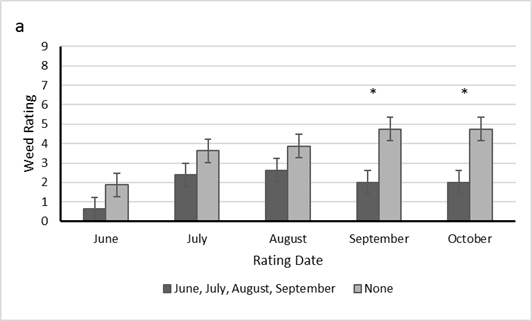
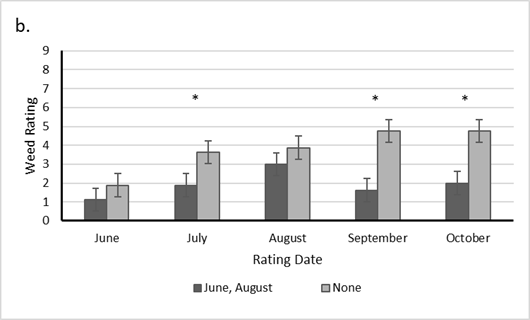
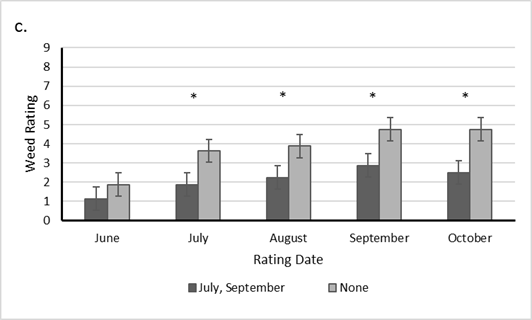
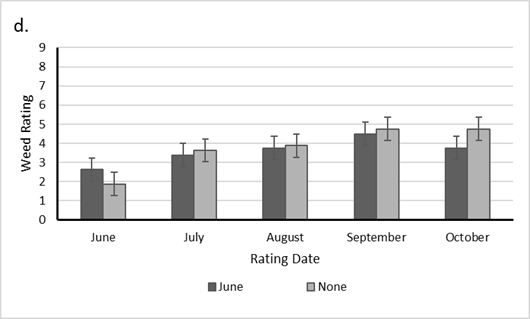
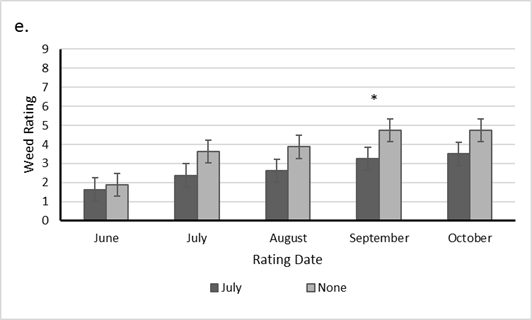
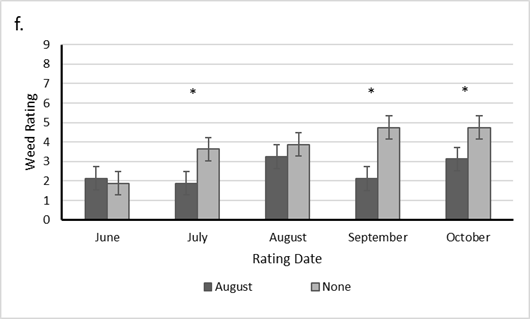
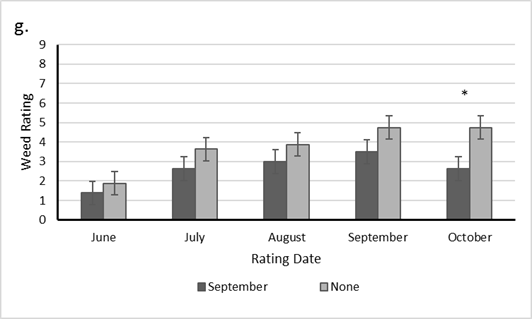
Figure 2 (a.-g.). Two year mean weed ratings by rating period. Each graph shows one mowing treatment compared to the control (None). a. Four mowings, b. June + August mowing, c. July + September mowing, d. June mowing, e. July mowing, f. August mowing, g. September mowing. *Asterisks denote significant differences at P < 0.05.
Discussion
Maintaining dense, competitive forages is a key to preventing weed invasion and interference in cool season grass and legume pastures. Weeds are opportunistic in their germination and establishment. They often favor open or disturbed areas which can be caused by livestock pugging soil when conditions in pastures are wet or over-grazed. Perennial, biennial and annual broadleaf weeds can have a negative effect on livestock production, so some farm managers mow pastures to reduce targeted weeds. This trial is an educational experiment to help landowners determine the best time, or times, to mow pastures to reduce broadleaf weed pressure. If one can reduce weed pressure by mowing at the appropriate time, the need for herbicide applications may be reduced or eliminated.
Results after two years indicate weed populations can be significantly reduced when mowing is done at specific times of the growing season. If farm operators only plan to mow once a year, results indicate that June is not the month. June mown plots were the only treatment after which weed coverage was not rated statistically less than the control. Plots mown in August had the lowest weed ratings in more periods than any other single mowing treatment, so August would be a good month if mowing only once per year. If farm managers in this region of Ohio plan to mow pastures more than one time per year, mowing in July and September could be effective, since this treatment treatment resulted in less weed coverage more times during the growing season. However, the June plus August timing could also provide producers two additional benefits. June provides timely removal of pasture plant seed heads to promote spring regrowth in pastured forages, and mowing a second time in early August is good timing for producers to start stockpiling forage in pastures. Also, when mowing multiple times a year, legume plants may thrive with less competition from tall grasses and become a higher percentage of the sward over a period of time (Laidlaw and Withers, 1998; Marriott, 1988). These factors could have a positive effect on forage quality in the plots for the future (Motazedian and Sharrow, 1990). In addition, forage quality and palatability of weeds is variable which can contribute to lessor quality feed offered to the animals (Bosworth et al., 1985; Marten and Andersen, 1975). Extension weed scientists Curran and Lingenfelter (2009) indicated that a single mowing will not satisfactorily control most weeds. However, mowing three or four times per year over several years can greatly reduce and occasionally eliminate certain weeds, including Canada thistle. Regular mowing helps prevent weeds from establishing, spreading, and competing with desirable grasses and legumes.
Economics of weed control is something that should be considered by producers. Ohio Farm Custom Rates 2016 state the average cost for a single brush hog pass across a pasture field is $17.84 per acre (Ward and Barker, 2016). Individual producers may evaluate their own costs for mowing pastures. Herbicide costs can be compared to mowing costs. A single application of the medium labeled rates of commonly used broadleaf herbicides in southeast Ohio ranged from $21.50 to $68.50/A. This total cost includes a $7.00/A application fee (Ward and Barker, 2016).
Conclusion
Desirable forages in pastures can benefit when mechanical mowing is done to suppress weeds and prevent reproduction. While a June only mowing treatment was not effective, any remaining grass seed heads were removed with June mowing to encourage new vegetative growth in grasses. Farmers have a variety of reasons for mowing pastures. If a producer can reduce weed pressure with strategic mowing, herbicide use may be reduced or eliminated, and legume growth enhanced. An increase in forage quality may then be seen and less nitrogen fertilizer required. Economics of mowing must be considered, but aesthetic value to some producers is worth additional costs associated with mowing. If producers plan to mow more than once per year, this study shows the multiple mowing treatments of June plus August, July plus September and monthly June through September result in similar weed reduction when compared to the control, but other factors may favor the June plus August treatment. Further work is needed to determine how mowing changes weed populations based on the timing of the mowing.
Literature Cited
Bosworth, S.C., Hoveland, C.S. and Buchanan, G.A. (1985). Forage quality of selected cool-season weed species. Weed Science, 34:150-154.
Curran, W. & Lingenfelter, D. (2009). Weed Management in Pasture Systems. Penn State University. Available at: http://extension.psu.edu/pests/weeds/control/weed-management-in-pasture-systems/extension_publication_file
DiTomaso, J.M. (2000). Invasive weeds in rangelands: Species, impacts, and management. Weed Science, 48:255-265.
Ferguson, J., Rathinasabapathi, B. & Chase, C. (2016). Allelopathy: How Plants Suppress Other Plants. University of Florida document HS944. Available at: http://edis.ifas.ufl.edu/pdffiles/HS/HS18600.pdf
Fynn, R.W.S., Morris, C.D., & Edwards, T.J. (2004). Effect of burning and mowing on grass and forb diversity in long term grassland experiment. Applied Vegetation Science, 7: 1-10
Laidlaw, A.S. & Withers, J.A. (1998). Changes in contribution of white clover to canopy structure in perennial ryegrass/white clover swards in response to N fertilizer. Grass and Forage Science, 53:287-291.
Marriott, C.A. (1988). Seasonal variation in white clover content and nitrogen fixing (acetylene reducing) activity in a cut upland sward. Grass and Forage Science, 43:253-262.
Marten, G.C. and Andersen, R.N. (1975). Forage nutritive value and palatability of 12 common annual weeds. Crop Science, 15:821-827.
Matches, A. G. (1979). Management. In R.C. Buckner & L.P. Bush (Eds.), Tall Fesuce (p.188). Madison, WI: American Society of Agronomy, Crop Society of America, Soil Science of America.
Motazedian, I. & Sharrow, S.H. (1990). Defoliation frequency and intensity effects on pasture forage quality. Journal of Range Management, 43:198-201.
Schnakenberg, T., Miller, P., Hobbs, J., Scheidt, J. & Kenyon, S. (2010). Pasture Weed and Brush Control. University of Missouri. Available at: http://extension.missouri.edu/stone/documents/ag/articles/PastureWeedBrushAug10.pdf
Turner, C. & Morris, B. (2015). Ohio Agriculture Statistics, 2015 Annual Bulletin. Available at: https://www.nass.usda.gov/Statistics_by_State/Ohio/Publications/Annual_Statistical_Bulletin/Master14.pdf
Ward, B. & Barker, F.J. (2016). Ohio Farm Custom Rates, 2016 Annual Bulletin. Available at: https://ohioline.osu.edu/factsheet/aede-11-16
